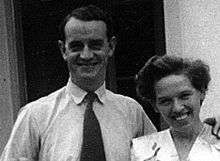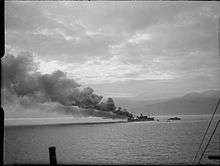Donald Sinclair (hotel owner)
Donald William Sinclair (10 July 1909 – 1981) was the co–proprietor of the Gleneagles Hotel in Torquay, England. He helped manage the hotel after an extensive career as an officer in the Merchant Navy and the Royal Navy. During World War II, he twice survived the sinking of the ship he was serving on.
Donald Sinclair | |
|---|---|
 Donald and Beatrice Sinclair | |
| Born | Donald William Sinclair 10 July 1909 |
| Died | 1981 (aged 72) |
| Nationality | British |
| Occupation | Merchant Naval Officer, Naval Officer, Hotelier |
| Known for | Being the inspiration for the fictional character, Basil Fawlty |
| Spouse(s) | Beatrice Coutts Ritchie (1940–1981; his death) |
| Children | Two[2] |
| Military career | |
| Allegiance | |
| Service/ | |
| Years of service | 1939–1946[1] |
| Rank | Lieutenant commander |
| Battles/wars | World War II |
Sinclair is primarily known for being the inspiration for the character Basil Fawlty, played by John Cleese, in the television sitcom Fawlty Towers that Cleese co-wrote. This was owing to his allegedly stuffy, snobbish and eccentric treatment of his guests, including Cleese and other members of the Monty Python cast.[3] Cleese later played a character named Donald Sinclair in the 2001 film Rat Race.
Wartime career

Prior to World War II, Sinclair was in the British Merchant Navy.[4] As an officer in the Royal Naval Reserve, he was called up in September 1939 for military service.[1]
Soon after his call up, he joined the crew of the armed merchant cruiser (AMC) HMS Salopian.[1] Salopian was a pre-war cargo liner that had been armed and converted into a warship as an emergency wartime measure. In May 1941, she was escorting a convoy in the North Atlantic. Early on the morning of the 13th, 400 miles south of Cape Farewell, Greenland, she was attacked by the U-boat U-98 in heavy fog. During successive attacks in the following six hours, Salopian was hit four times by torpedoes. Her engines were knocked out but she remained afloat and engaged the surfaced U-98 with gunfire. Salopian finally sank after a fifth torpedo broke her in half. All but three of the crew survived and were picked up the next day by the destroyers HMS Impulsive and HMS Icarus.[5][6]
In July 1941, Sinclair joined the crew of the infantry landing ship HMS Karanja.[1] In May 1942, Karanja took part in Operation Ironclad, the British invasion of Vichy French-controlled Madagascar. In November 1942, she took part in Operation Torch, the Allied invasion of French North Africa. On the morning of 12 November, at Bougie, Algeria, Karanja was hit in the engine room by at least two bombs from a German Junkers 88 bomber and set on fire, before subsequently sinking.[7][8]
From February 1943 until July 1945, Sinclair served on the escort carrier HMS Trumpeter. Trumpeter served in European waters, her duties included escorting convoys to the Soviet Union. With the end of the war in Europe, the ship was reassigned to the Far East and arrived Colombo in July 1945. Trumpeter was one of the ships assigned to take part in Operation Zipper, the recapture of Malaya,[9] but the ending of the war meant only small part the planned attack was carried out.
Sinclair left the navy in April 1946 with the rank of Lieutenant commander.[1]
Hotel career and later life

Sinclair married Beatrice Ritchie (1915–2010) in Glasgow during the war. She was a policeman's daughter from Ellon, Aberdeenshire, who worked as a fashion consultant and designer at a Glasgow department store. She moved to Torquay to live with an aunt and avoid the German bombing of Glasgow. After the war ended, while her husband was still serving at sea, she opened a hotel in Torquay called Greenacres.[4] The business was a success and in 1964, she bought a private house that she transformed into a second hotel. She named this Gleneagles after her favourite part of her native Scotland. By this time, her husband was assisting her in running the business.[2] He made this decision reluctantly and would have preferred to remain at sea.[10]
Sinclair died in Torquay, Devon in 1981 aged 72, from a heart attack and stroke "when some workmen he'd upset painted his patio furniture and car gunmetal grey during the night."[11] His wife died 29 years later in September 2010; they are survived by their two daughters.[2]
Fawlty Towers
The Monty Python cast met the Sinclairs while staying at the Gleneagles Hotel in May 1970; they were filming in nearby Paignton. Sinclair was reluctant to let them stay, but his wife argued in favour of them, as their three-week stay in the hotel represented a considerable amount of business during the hotel's off-season.[12] Sinclair's actions included criticising American Terry Gilliam's table etiquette and throwing Eric Idle's briefcase out of a window because he thought it contained a bomb. The Monty Python cast left the hotel for other accommodation with the exception of John Cleese and his then-wife Connie Booth.[13] Cleese later used his mannerisms as an inspiration for Basil Fawlty in Fawlty Towers.[14] Several of the show's plot lines are alleged to be based in part on real-life events;[15] the Gleneagles Hotel is referenced in the show's second episode, "The Builders".
Cleese later played eccentric hotel owners in the 1999 remake film The Out-of-Towners and the 2001 movie Rat Race; in this latter piece, his character was called Donald Sinclair.
Accuracy
Opinions are divided on how closely Sinclair resembled Fawlty. Former staff and visitors have remembered actual events there that were as ludicrous as those depicted in the series.[16][17][3] However, Sinclair's family is adamant that Fawlty was an inaccurate caricature.[10] Beatrice Sinclair later described her husband as a "gentleman and a very brave man" and not "the neurotic eccentric that John Cleese made him out to be." An accuracy she did acknowledge is that she was very much in charge of the business, just as Basil Fawlty was usually subordinate to his wife Sybil.[10] The publication of Sir Michael Palin's diaries in 2006 supported Cleese's assessment of the Sinclairs.[18] Rosemary Harrison, a waitress at the Gleneagles under Sinclair, stated,
Fawlty Towers was terribly funny. John Cleese exaggerated the character but the basic things are there. He probably wasn't neurotic but he was just so bad-tempered. It was as if he didn't want the guests to be there. He was bonkers. He thought it ridiculous that people wanted to drink at lunchtime. These were paying guests. They would be out by the pool looking for a drink and he hadn't opened the bar. He just wasn't cut out for the hotel business.[19]
References
- "Royal Naval Reserve (RNR) Officers 1939–1945". unithistories.com. 27 September 2011.
- "Beatrice Sinclair (Obituary)". The Daily Telegraph. 16 September 2010. Retrieved 16 September 2010.
- Donaldson, William (2002). Brewer's Rogues Villains and Eccentrics. Cassell. p. 574. ISBN 0-304-35728-6.
- "Obituary: Beatrice Sinclair, fashion designer, dance hostess and hotelier". Kirkintilloch Herald. 28 September 2010. Archived from the original on 6 January 2014. Retrieved 20 January 2013.
- Daniel Morgan; Bruce Taylor (9 November 2011). U-Boat Attack Logs: A Complete Record of Warship Sinkings from Original Sources 1939-1945. Seaforth Publishing. pp. 96–100. ISBN 978-1-84832-118-2.
- "HMS Salopian (F 94)". uboat.net. 27 September 2011.
- "HMS Karanja (F 128)". uboat.net. 27 September 2011.
- John Weal (20 September 2012). Junkers Ju 88 Kampfgeschwader in North Africa and the Mediterranean. Osprey Publishing. p. 73. ISBN 978-1-78200-445-5.
- "A History of H.M.S. TRUMPETER". www.royalnavyresearcharchive.org.uk. Retrieved 16 June 2020.
- Richard Saville (10 May 2002). "My husband was not like Basil". The Daily Telegraph. Retrieved 28 August 2008.
- "Perfecting the art of rudeness". The Spectator. Retrieved 3 March 2016.
- "Cleese's memory was clearly faulty". Plymouth Herald. 22 September 2010. Archived from the original on 23 November 2015. Retrieved 27 June 2014.
- "John Cleese in conversation with Eric Idle". Livetalksla.org. 18 November 2014. Retrieved 3 March 2016.
- "Devon - Features - Sybil back at Fawlty Towers". BBC. 18 September 2006. Retrieved 3 March 2016.
- "The REAL Sybil dies aged 95: Woman's Torquay hotel helped inspire Fawlty Towers". Daily Mail. 17 September 2010. Retrieved 10 April 2013.
- Richard Saville (17 May 2002). "Fawlty hotelier was bonkers, says waitress". The Daily Telegraph. Retrieved 28 August 2008.
- Yvonne Swann (1 July 2008). "Paula Wilcox's heaven and hell". The Daily Telegraph. Retrieved 1 July 2008.
- Diaries 1969–1979 – The Python Years (published 2006) – In the entries for 11 and 12 May 1970, it is recounted that Sinclair saw the Pythons as a "colossal inconvenience" and when Michael Palin and Graham Chapman decided to leave after one night, Beatrice Sinclair gave them a bill for two weeks.
- "Fawlty hotelier was bonkers, says waitress". The Telegraph. Retrieved 24 May 2019.